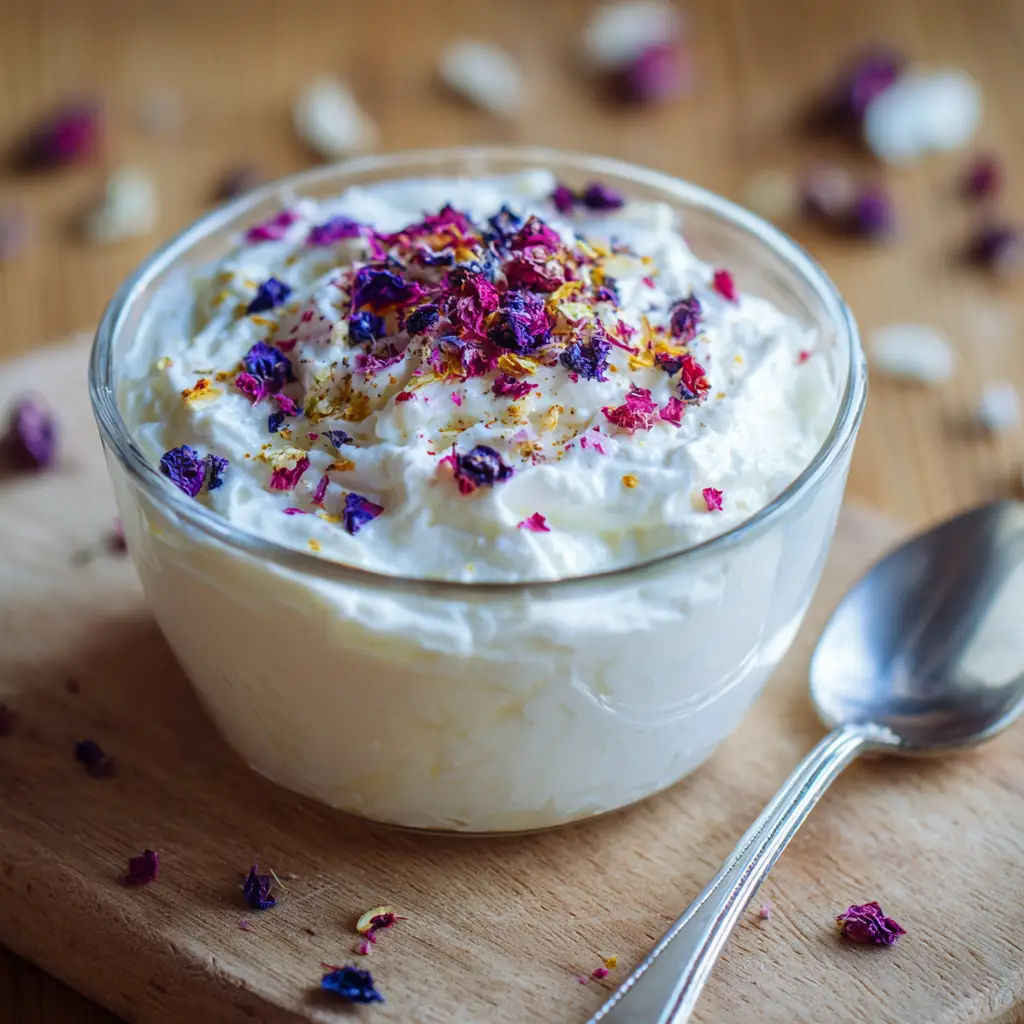Greek Yogurt Recipe – How to Make Thick and Creamy Homemade Greek Yogurt Easily
Introduction
In this article you will find everything you need: from the ingredients needed to make an excellent batch of Greek yogurt, to step-by-step instructions, ways to customise it, full nutritional information, how to serve it and more. Whether you are new to Greek yogurt or already a fan looking to deepen your understanding, this guide will help you incorporate it into your diet with confidence and delight.

Ingredients Needed
Here is a clear table listing the ingredients you will need for a basic batch of Greek yogurt and approximate calorie counts for each ingredient. These counts are rough estimates and will vary slightly depending on brand or specific milk used.
| Ingredient | Amount | Approximate Calories |
|---|---|---|
| Whole milk (or 2 % milk) | 4 cups (about 1 litre) | ~600 kcal (≈150 kcal per cup) |
| Plain yogurt with live cultures | 3 tablespoons | ~45 kcal |
| Optional: salt (for savoury version) | ¼ teaspoon | ~0–2 kcal |
Notes: If you choose low-fat milk the calorie count may drop somewhat. The plain yogurt starter will contribute negligible calories in comparison to the milk. Also if you plan to flavour the finished Greek yogurt (with honey, fruit, nuts) you will add additional calories beyond this base.
Step-by-Step Cooking Instructions
- Heat the milk: Pour the milk into a heavy-bottomed pot and warm it over medium heat until it reaches about 185 °F (85 °C). This heating helps change the milk proteins so the yogurt will set firmly. A gentle stir helps prevent scorching.
- Cool the milk: Remove the pot from heat and allow the milk to cool down to roughly 110 °F (43 °C). At this temperature the live cultures in the yogurt starter will thrive without being damaged.
- Add the yogurt starter: Take a small bowl, mix the 3 tablespoons of plain yogurt with a little of the warm milk to smooth it out. Then stir that mixture back into the pot of warm milk. This spreads the culture evenly.Continue your cooking journey with Granola Bars_ right after this.
- Incubate: Cover the pot with a lid, wrap the pot in a thick towel or place it in a warm spot. Let it sit undisturbed for about 6-10 hours until the milk transforms into yogurt—thick and mildly tangy. The longer you leave it (within reason), the stronger the flavour will become.
- Strain the yogurt: To make it Greek style you must remove some of the whey (liquid). Line a fine mesh strainer with a cheesecloth or muslin, place it over a bowl, and pour the set yogurt into it. Cover and place in the fridge to drain for 2-4 hours (or longer if you prefer a firmer texture).
- Transfer and chill: After draining, transfer the thickened yogurt into a clean container. Chill it in the refrigerator for at least a couple of hours before serving. The texture will set further as it cools.
- Save a bit for next batch: If you like, reserve 2-3 tablespoons of your batch to serve as the starter culture for your next batch. It helps maintain the live culture chain.
These steps mirror traditional techniques. A detailed guide describes heating to 160-185 °F and straining to achieve the thicker consistency.

Tips for Customizing the Recipe
- If you prefer a lighter version, use 2 % or low-fat milk. The yogurt will be slightly less rich but still creamy.
- For extra thickness, extend the straining time. The longer you strain, the more whey is removed and the firmer the result.
- To add flavour, mix in vanilla extract, honey, or maple syrup after straining. Reserve plain portion for savoury applications.
- For a savory twist, stir in a pinch of salt, garlic powder or chopped fresh herbs. Use the yogurt as a dip, spread or dressing.
- If you like fruit and nuts, top your serving with fresh berries, sliced banana, chopped almonds or walnuts. These additions introduce healthy fats and fibre.
- For dietary variation, you can use lactose-reduced milk or even plant-based milks adapted with yogurt starter—but the texture and culture behaviour may differ.
- If making for dessert or indulgence, fold in a spoonful of dark chocolate chips or swirl in fruit compote—still more nutritious than heavier cream-based desserts.
- To keep your culture going, save some yogurt as the starter for your next batch instead of buying a new one each time. That creates continuity.

Nutritional Information
Here is a rough nutritional profile for one cup (approximate 245 g) of plain whole-milk Greek yogurt (before toppings or additional flavouring). Actual values depend on milk fat percentage and exact straining.
Health highlights:
- Rich in protein which helps with muscle repair and satiety.n
- Contains live cultures (probiotics) supporting digestive health.
- Good source of calcium and other minerals beneficial for bone health.
Serving Suggestions
- Breakfast bowl: Serve one cup of Greek yogurt topped with fresh berries, a drizzle of honey and a sprinkle of chopped nuts.
- Smoothie base: Blend yogurt with banana, spinach, frozen mango and a splash of almond milk for a creamy morning smoothie.
- Dip or spread: Combine yogurt with chopped cucumber, garlic and dill to make a quick tzatziki-style dip. Use as a vegetable dip or spread for pita or crackers.
- Savory sauce: Stir into warm soups or grain bowls to add creaminess without heavy cream.
- Dessert alternative: Mix yogurt with cocoa powder, maple syrup and raspberries for a healthier chocolate treat.
- Marinade: Use yogurt as a marinade for chicken or fish—its acidity helps tenderise the meat while adding flavour.
- Snack: Spoon it straight from the fridge with a spoonful of nut butter and sliced banana for a high-protein snack.
Greek Yogurt Recipe – How to Make Thick and Creamy Homemade Greek Yogurt Easily
Course: Blog4
servings15
minutes10
minutes150
kcalIngredients
IngredienttAmount
Whole milk (or 2% milk)t4 cups (about 1 liter)
Plain yogurt with live culturest3 tablespoons
Optional: salt (for a savory version)t¼ teaspoon
Directions
- Warm the milk
- Pour the milk into a heavy saucepan and heat it gently until it reaches about 185°F (85°C). Stir slowly to prevent it from burning.
- Cool down
- Remove from heat and allow the milk to cool to around 110°F (43°C). It should feel warm but not hot to the touch.
- Add the starter
- In a small bowl, mix 3 tablespoons of plain yogurt with a little of the warm milk. Then stir that mixture back into the rest of the milk to distribute the live cultures evenly.
Recipe Video
Notes
- For a richer texture, use whole milk and strain longer.
For lighter yogurt, choose low-fat milk or shorten the straining time.
Always reserve a few tablespoons of your homemade Greek yogurt as a starter for your next batch.
Frequently Asked Questions
What makes Greek yogurt different from regular yogurt?
Greek yogurt is made by straining out much of the whey (liquid portion) after fermentation, so it becomes thicker and higher in protein, and lower in carbohydrates compared with regular yogurt
Can I make Greek yogurt without special equipment?
Yes. You only need a pot, thermometer (helpful but not strictly required if you monitor by feel), a fine mesh strainer or cheesecloth for draining, and a warm place for incubating. Many home recipes use everyday kitchen tools.
How long will homemade Greek yogurt keep?
Stored properly in the refrigerator in a clean airtight container, it typically stays good for about a week. The texture and tang may deepen with time, so consume within this window for best quality.
Is Greek yogurt good for lactose-intolerant people?
Because Greek yogurt is strained, it tends to have lower lactose content than unstrained yogurts. Some individuals with mild lactose intolerance tolerate it better. However, anyone with significant lactose sensitivity or dairy allergy should proceed with caution or choose dairy-free alternatives. Information from a health overview emphasises checking the fat content and sugar content.
Conclusion
When you want a dairy food that delivers on taste, nutrition and flexibility in the kitchen, Greek yogurt stands out. Its thick, creamy texture invites creativity while its high protein and probiotic-rich profile support health in meaningful ways. Whether you enjoy it plain, top it with fruits and nuts, swirl it into savoury dishes, or use it as a foundation for desserts and marinades, Greek yogurt adapts beautifully.







